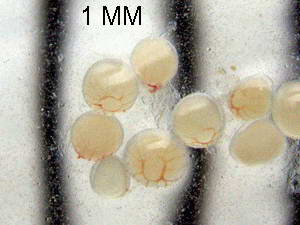CORAL REEFS - What are they, where are they and what types there are.
REEFS ON THE WEB - An exensive collection of very informative sites.
THE COLLECTION AND TRANSPORTATION OF CORALS, FISH AND LIVE ROCK - A very good read!
RENAMING OUR CORALS - Lets get a little more specific please.
REEF COLLECTING - For those of you who are able to do your own ocean collecting.
THE NUTRIENT DYNAMICS OF CORAL REEFS Part Two - A must read in my opinion.
CORALPEDIA - CARIBBEAN SPECIES - Not listed under the ID section since we can not keep these species, but a very good visual site.
LIGHT, COLORS AND CORALS - What influences and creates coral coloration.
CORAL FLUORESCENCE - How corals do it and why they do it.
CORAL FUSION AND GRAFTING - Just when you thought it couldn't get any stranger.
ZOOXANTHELLAE - This article discusses Clads "A" and "B".
CORAL POLYP EXPANSION - Not a good indicator of coral health as many variables can dictate this behaviour.
CORAL AGGRESSION - The mechanisms corals have to attack other corals. See
Nematocysts also.

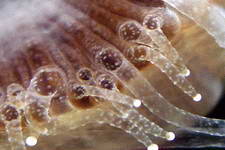
Sweeper tentacles
CORAL FEEDING STRATEGIES Part One of Seven -
What foods corals utilize and how they utilize them.
Part Two Part Three Part Four Part Five Part Six Part Seven
PHOTOSYNTHESIS AND THE REEF AQUARIUM - Carbon sources, Looks at photosynthesis in reef aquaria from a chemical perspective.
Corals optical ability ? - "
In many species of symbiotic corals, spawning occurs synchronously
several nights after the full moon. This process is correlated with the
level of lunar irradiance, but the mechanism by which these
cnidarian/zooxanthellate symbioses can detect such low levels of light
remains unknown. Here we report the first biophysical evidence that the
host animal exhibits extraordinarily sensitive photoreception in the
blue region of the spectrum. Using a high-resolution laser-induced
signal to detect tentacle scattering, we measured the effect of low
irradiance on the contraction of polyps in the corals that normally
have their tentacles extended in darkness. Similar to most deep-sea
invertebrates, the action spectra of coral photoreception reveal a
maximum sensitivity in the blue, at 480 nm, with a spectral band width
(at full-width half-maximum) of ca. 110 nm. The spectra closely overlap
the maximal transparency of oligotrophic tropical waters, thus
optimizing the perception of low light at depth. The detected threshold
of photoreception sensitivity is ~1.2 x $10^{15}$ quanta
$m^{-2}\,s^{-1}$ in the blue region. This makes corals capable of
sensing the blue portion of lunar irradiance, as evidenced from the
recorded slight contractions of polyp tentacles under variations in
moonlight intensity."


Most corals are Broadcast spawners releasing gametes once a
year, sometimes twice a year. Such spawning events usualy occur over
the coarse of a few nights. A small minority of corals are brooders,
releasing their planulae monthly or every few months.
SEXUAL REPRODUCTION - The release of eggs / sperm into the ocean's currents as shown in the above graph.
Shown below is my Pavona sp. releasing sperm.
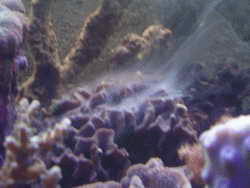
Common Asexual Reproductive methods:
Longitudinal Division: This is where the coral divides into approximately
equal halves, thirds, quarters, etc, like when a pizza is cut. Each piece has
part of the oral (mouth) and basal (foot) disc then heals up and forms a new
coral, typically moving away from the other corals.
Budding: This
is where the parent polyp will form a slight projection somewhere on its body
and a new polyp will form at this point. The new polyp, called the daughter
polyp, will either stay attached to the parent polyp or detach from the parent
polyp and grow into a new coral.
Pedal Laceration: This is where a
portion of the basal disc will detach from the parent polyp. Then either the
parent polyp moves away (most common) or the portion of the basal disc will move
away. Eventually the fragment of the basal disc will grow into a new
coral.
Stolon Growth: A "runner" is sent out from the base of an
existing polyp. As this runner (called a stolon) grows, it begins to form new
polyps along its length. The stolon can be very thin, sometimes breaking in
pieces, or it can develop into a thick mat, depending upon the species. This is
seen most commonly in zoanthids.
Transversal Division: This is
where the coral will split along a horizontal line between the base of the coral
and the top of the coral. The oral disc will be carried away by water currents
and if it survives it will attach and grow a new foot. The basal disc will
simply regrow a new oral disc and mouth. This is most commonly seen in
Actinodiscus sp. mushrooms.
Fragmentation: This is where a
portion of the coral is deliberately released by the parent colony (as opposed
to a wave breaking a coral in nature or a careless hand breaking a coral apart
in our tanks) and attaches in a new location to form a new coral. This is
commonly seen in
Capnella sp. or other similarly structured soft
corals.
Self-Fertilization: This is when a male polyp releases sperm into the water and
that sperm fertilizes an egg from a female polyp in the same coral colony.
POLYP BALL FORMATION - First reported in a Goniopora species
where the colony forms little miniature versions of itself, complete
with skeletal mass and drops them. The photos below are of my Goniopora
species doing the same.
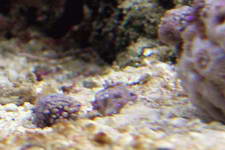

THE PRESENCE OF GONADOROPIN-RELEASING HORMONES
- The objectives of this study were to investigate the presence of
immunoreactive GnRH (irGnRH) in scleractinian coral, Euphyllia ancora,
study its seasonal variation, and evaluate its biological activity.
TROPICAL CORAL REEF ENVIRONMENT RHYTHMICITY AND TECHNIQUES FOR INDUCING CAPTIVE CORAL SPAWNING - " Modern captive coral reef aquaria ecosystems have attained the capability for
supporting the long term healthy maintenance of many tropical reef corals. The
stimulation of asexual reproduction has also occurred for many species and
captive propagation is proceeding slowly. "
For those interested, and you should be, in having corals
reproduce within an aquarium setting, the best chance we have of being
successful is by keeping those species that reproduce by planulae
brooding, this is where the corals eggs are fertilized
internaly, forming planulae (coral larvae) which are then released.
This type of reproduction gives us the best chance at having
corals reach settlement and form new colonies. Below is a list of
coral species that are known to be brooders as provided by Eric Borneman.

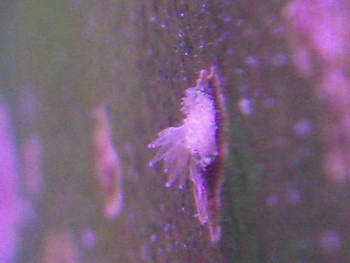
Photos taken on 6 Nov. 09 in my aquarium, with a count of 39 new coral recruits
Agaricia agaricites, Agaricia fragilis, Agaricia humilis, Agaricia
tenuifolia, Alveopora daedalea, Alveopora japonica, Astroides
calycularis, Balanophyllia elegans, Balanophyllia europaea, Balanophyllia
regia, Caryophyllia cyathus, Cladopsammia rolandi, Cyphastrea
ocellina, Euphyllia glabrescens, Euphyllia rugosa = glabrescens?, Eusmilia
fastigiata, Favia fragum, Favia gravida, Flabellum curvatum, Flabellum
impensum, Flabellum thouarsii, Galaxea horrescens, Goniastrea
aspera, Goniopora decima, Heliofungia actiniformis, Isophyllia
sinuosa, Isopora brueggemanni, Isopora cuneata, Isopora
palifera, Leptopsammia pruvoti, Letepsammia formosissima, Madracis
formosa, Madracis mirabilis, Madracis myriaster, Madracis
pharensis, Madracis senaria, Manicina areolata, Monomyces
rubrum, Mycetophyllia ferox, Pocillopora damicornis, Porites
astreoides, Porites furcata, Porites heronensis, Porites
murrayensis, Porites panamensis, Porites porites, Porites
sillimaniani, Porites stephensoni, Rhizopsammia minuta, Scolymia
wellsii, Seriatopora caliendrum, Seriatopora hystrix, Siderastrea
radians, Siderastrea stellata, Stylaraea punctata, Stylophora
pistillata, Trochopsammia togata, Tubastrea aurea, Tubastrea
coccinea, Tubastrea diaphana, Tubastrea faulkneri.

Far to often I see forum threads started asking what
species a certain coral is, while showing a photo or two (often blurry)
of a coral within an aquarium. I understand that everyone would like to
know what species they have, and it is important to know, if possible,
what you have as it allows you to better understand how to care for a
specific species.
What is perplexing though is that few hobbyist seem to
understand what is involved in determining species identifications.
While there are a few, very few, corals that one can glance at and know
its species (elegant corals as an example), The vast majority of corals
will have to have a skeletal examination done in order to determine
species. While a photo may allow you to narrow the coral down to a
genus group or two, it will most likely never allow you to determine
species.
If you truly want to know, and be sure of a species
identification, it will be up to you to either provide clear, in focus,
macro photos of the corals skeletal features to allow others to
identify your coral, or you will have to take the time and effort to
learn how to do such examinations. The links provided below will get
you off to a very good start.
STONY CORAL IDENTIFICATION PRIMER FOR AQUARISTS - " These articles will present information required to properly identify many
corals and what the obvious features tell us as reefkeepers. "
A SIMPLIFIED GUIDE TO BASIC LEVEL IDENTIFICATION - Terminology, Basic identification features of corals.
CORAL GENUS IDENTIFICATIONS - My own webpage listing pictorial stony coral genus groups.
ACROPORA IDENTIFICATION KEY - A very usefull identification key for the acropora genus.
GLOSSARY OF CORAL MORPHOLOGY - Terminology and identification featues used to identify species.
CORALLITE ORDER & CYCLE EXAMPLES - A key to corallite identification features.
Since it happens often enough, I think it is important enough to
discuss. I have seen a great many online questions regarding the loss
of Acropora species as well as having other corals slowly becoming
unhealthy and eventualy dieing. A great many times, this can
be attributed to an improperly stocked aquarium. In that, we all would
like to see a nice mixture of coral species within our systems. Yet
this same mixture will most always lead to trouble in being able to
maintain the more sensative species such as the acroporas.
Of course, elevated levels of nutrients and the overall quality
of the water can
play a large role as well. If you are trying to keep coralliamorphs,
gorgonians, large polyped corals and others, such as hydnophora,
galaxea or any of the "soft" corals. You are in effect, possibly
creating a toxic soup within your aquarium through the release
of such coral's chemicaly defesensive methods (allelopathy).
If you see your Acropora species losing tissue fairly quickly,
you might want
to take a hard look at what species you are keeping together. If you
wish to keep species such as the Acroporas and Montiporas, I suggest
you keep only those species in your aquarium.
THE USE OF PHYTOPLANKTON - I am sure like many of you, when I
first started out, the store shoved a bottle of phytoplankton at me and
said I would need it to feed my corals. Of course years later, I find
out that corals do not actualy consume phytoplankton, they may
inadvertantly capture it, but will soon reject it. This is not to say
that you should not provide phytoplankton to your aquarium though.
There are, or at least, there should be a good many other
creatures in your aquarium that will benefit from the dosing of
phytoplankton. Any number of copepods, worms, and a host of other very
small animals feed on nothing but phytoplankton and other algae. By
being well fed, they will in turn reproduce and in their swimming or
crawling about, will feed your corals. Just as they do out on the reefs.
FEEDING YOUR CORALS - I have two words on this subject, DO IT.
It simply amazes me to hear others stating that they never feed their
corals since corals get everything they need from the light. Granted,
the light provides for the needs of the coral's zooxanthellae
which in turn provides for the coral's energy needs. They do not
however, provide for the corals protein needs. A requirement for
growth, reproduction and healing.
Such protein only comes from feeding. Without it, a coral must
resort to direct nutrient uptake out of the water, and if the aquarium
is being kept as nutrient free as possible, what does that leave the
coral to eat if they are not being fed actual food? Besides, why would
a coral polyp have a mouth and the tentacles / filaments to gather and
eat food if they did not need them? Its just common sense that they
require food, and a great deal more of it than you would think.
If you have, or ever get to have the chance to dive on a coral
reef at night, you would be amazed at how thick the water is with tiny
swimming / drifting life forms, all of which the reef's corals actively
capture and eat, each and every night. In addition to eating plankton,
there is also a great deal of particulates (organic debris) available
to the corals at all times of the day. In short, corals eat food, and
they eat a lot of it. So please, feed your pets and stop starving them.
HOW MUCH LIGHT
- A perfect example of how corals do not all need high intensity
lighting, in fact, for a good many coral species, such high intensity
is actualy very harmfull to them. Please take the effort to study each
species that you wish to keep.
CORAL DISEASES AND PARASITES - Common coral problems with additional links provided.
CORAL FEEDING ARTICLE - What to feed, how to feed.
DETRITUS - An excellent article which to me, is yet another good reason to not use particle trapping filters.
FEEDING A CORAL REEF AQUARIUM - How and what to feed all of the inhabitants of a typical reef aquarium.
REEF TANK FEEDING RECIPE - Make your own reef foods.
CORAL LIGHTING ACCLIMATION - How to safely acclimate your new corals to your system.
CORAL PHOTOACCLIMATION & PHOTOADAPTATION - An indepth article on acclimating corals.
THE LITTLE BRAIN THAT COULD - An example of how to care for a damaged coral.
LIGHTING - Selection and Recommendation Links (also found within the equipment section).
THE USE OF SUPPLEMENTS AND ADDITIVES - My opinion on this subject.
WHAT IS THE PROPER TEMPERATURE FOR REEF ORGANISMS? - Dr. Ron Shimek's article
Coral Feeding : ( Quote Eric Borneman ) Corals need carbon,
nitrogen, phosphorus and other trace and minor elements (these are
largely unknown). The degree to which they get them depends on the
sources - they can absorb from the water column, feed on particulates,
use photosynthesis, use bacteria (directly and from their metabolic
breakdown-products that they produce growing on the surface of the
corals) and from prey capture. Most carbon is from photosynthesis and
feeding. Most nitrogen is from feeding - if you have a lot of
particulates and/or the corals has relatively low metabolic needs, it
might be able to "extract" what it needs from the water. If not, then
you should feed the corals. Chances are in tanks, prey is very limited
compared to the wild. So, I think feeding is a good idea. Target
feeding is fine, but use of water column particulate prey or psuedo
prey like Artemia nauplii, Cyclop-eeze, oyster eggs, rotifers, etc is
just fine provided there is a good amount in the water column for
little polyps to feed. A half teaspoon a night in a 180 packed with
corals, for instance, is pretty useless. Target feeding, for me, is a
pain. I just load the water column so the tank water is awash in
particles. I am pretty sure most every polyp gets several mouthfuls
without going to the trouble of target feeding. If you have the
patience and few enough corals to do this, great! Also, there is no
"rule" on which corals need to be fed since they all feed - except for
the handful of soft corals, Mycetophyllia, and Pachyseris which also
feed, but in a different way."
How I feed my corals and planktivore fish : Since Linda and I eat
a good deal of fresh fish bought from the local markets, usualy small
mackeral species, I have found that at least one, usualy more, of the
fish when being cleaned for dinner contains a good amount of roe.
Having noticed how small the eggs are, it dawned on me that I have a
year round ready supply of fresh food to feed my reef system with.
As such, I simply collect the roe which are contained in an
extremely thin, transparent sack that is easily broken by simply
scraping the edge of a teaspoon across it. Once completed, I
simply mix the eggs into a large cup of tank water and refridgerate for
ready use.
BUSTING THE HYPE
First, I have to say that it is a crying shame that I feel the
need to have such a catagory, but with the hobby continualy bombarded
with hype, experimental methods, voodoo
science and wishfull thinking, A few such topics need to be addressed.
Dosing Sugar or Vodka - A great new method or aquarium russian roulette ?
Supplementing Amino Acids - Another case of hype before the science.

SECURING PROPOGATED CORALS - Now that you cut your favorite coral in half, how do you secure it?
CORAL FRAGMENTATION - How to properly fragment a coral.
PROPAGATION OF SMALL POLYPED STONY CORALS - How to properly fragment small polypedcorals.
CORAL CULTURE IN SUSPENSION - A method for growing out coral fragments.
UNUSUAL STONY CORAL PROPOGATION TECHNIQUES - The title says it all.
GROWING CORALS FROM SEXUALY PRODUCED LARVAE - A new approach to farming corals.
THE FRAGGING PHENOMENON - Another good coral fragging article.
FRAGGING ZOANTHIDS - A great article on how to do it safely, also a great zoanthid website.
Genus/Species Specific Information:


















